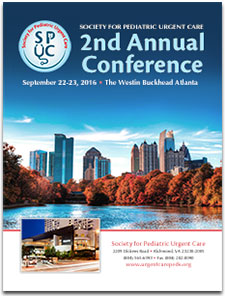SPUC Clinical Advisor
“Fever and cough.” “Cough and fever.” “Bad cough.” “Difficulty breathing.” Winter (aka Respiratory Season) in urgent care is here with a vengeance! When you are in the midst of a busy night at urgent care and all of the chief complaints (and patients!) are starting to blend together, it is important to tease out which patients need immediate intervention versus expectant care and reassurance. Croup is one clinical syndrome which has a broad spectrum of presentations. The parent says their child is wheezing…but is that stridor you hear? The oxygen saturation is normal, but does that mean there is no treatment necessary? If a child sounds like they have croup, but is febrile and unimmunized, what other things must you consider in your differential?
The answers to your clinical questions about croup can be found at http://www.urgentcarepeds.org/clinical/.
Here’s a look at our Croup Clinical Advisor:
Croup
ALERTS
- Epiglotitis
- Bacterial tracheitis
- Peritonsilar/Retropharyngeal abscess
- Foreign body
- Anaphylaxis/allergic reaction
- Upper airway injury
- Congenital anomalies
AGE OR PREGNANCY CONSIDERATIONS
- < 4 years = typical presentation
- Chronic croup can remain in older children
DIFFERENTIAL DIAGNOSIS
- Epiglotitis
- Peritonsilar/Retropharyngeal abscess
- Laryngomalacia
- Foreign body
- Anaphylaxis/allergic reaction
- Upper airway injury
EVALUATION
HISTORY
- Onset and timing of cough, presence of stridor and hoarseness, level of distressed breathing, presence of drooling, alleviating factors, associated symptoms (fever, congestion, coryza).
- Progression of symptoms since onset
- Nocturnal worsening of symptoms
- History of croup
- History of wheezing/RAD/Asthma
- History of congenital airway anomalies
- Irritability, poor feeding/hydration – Infants/young children
- Recent exposures – daycare
PHYSICAL EXAM
- HEENT – Uvula position, peritonsilar/retropharyngeal space
- Respiratory – RR, O2 saturation
- Cardiovascular – HR, hydration, perfusion
- Neuro – Mental status, irritability
Diagnostic Findings
- HEENT – Congestion, coryza
- Respiratory – Tachypnea, hypoxia if severe
- CV – Tachycardia, decreased perfusion
- Neuro – Fussiness
Concerning Findings
- Stridor at rest
- Drooling
- Anxious appearance/distress
DIAGNOSTIC TESTS & INTERPRETATION
Lab Tests
- RSV
- Influenza
- Parainfluenza
Imaging
- AP/lateral neck films – “steeple sign”
- Neck CT – if concern for abscess
- Additional Chest films – if concern for foreign body
Diagnostic Testing
- N/A
MANAGEMENT
TRANSFER/ADMISSION CONSIDERATIONS
- Severe distress/anxious appearance
- Toxic appearance
- Persistent hypoxia
- Airway foreign body
CROUP TREATMENT
First Line
- Dexamethasone PO/IM
- Nebulized Racemic Epinephrine
- Must monitor and reassess two hours after administration for rebound edema
Second Line
- Prednisone
Supportive
- Humidified air/Cool air (saline neb, steamy shower, outside air)
- Fever relief
FOLLOW UP
Outpatient Referral
- PCP in 24 hours
- ENT if chronic severity
Written instructions should include:
Anticipatory Guidance
- Importance of increased fluids
- Use of humidified air/cool air
Activity, Diet
- Activity as tolerated
- Increase fluids
Signs and Symptoms to Return
- Drooling
- Stridor at rest
- Wheezing/respiratory distress
- Persistent fever
- Lethargy
PROGNOSIS, COMPLICATIONS
- Self-limited illness
- Typically responds well to steroids
- Can progress to respiratory emergency in severe cases
- Can exacerbate asthma in predisposed patients
REFERENCES:
Fleisher G, Ludwig S. (Eds.). Textbook of Pediatric Emergency Medicine. 6th ed. Philadelphia, PA: Lippincott, 2010.
Hay, W., Levin, M., Deterding, R., Abzug, M. (Eds.). Current Diagnosis & Treatment – Pediatrics. 22nd ed. New York: McGraw Hill, 2014.
Engorn, B. & Flerlage, J. (Eds.). (20th ed., 2015). The Harriet Lane Handbook. Philadelphia: Saunders.
Textbook of Pediatrics. 19th ed. Philadelphia, PA: Saunders Elsevier, 2011.




